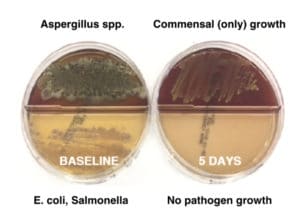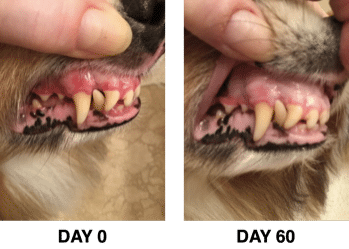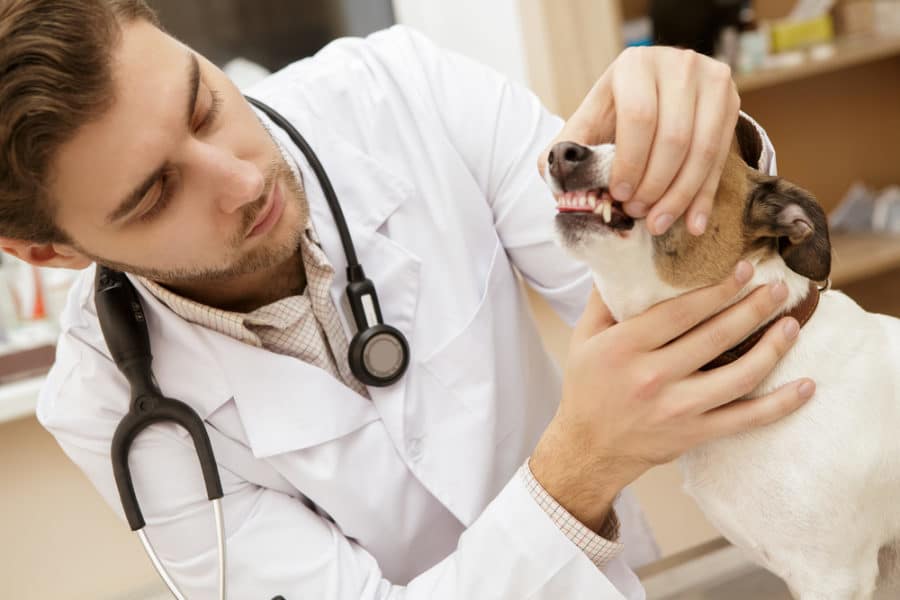Oral dysbiosis is a driver of dental disease in dogs. Here’s how a unique new approach targets the oral microbiome to block pathogen growth and restore balance.
Oral dysbiosis, an imbalance of the microbial community that inhabits the oral cavity, strongly correlates with dental disease in humans, dogs, and other animals. Oral dysbiosis occurs concomitant with signs of gingivitis and periodontal disease in healthy animals after challenges with Porphyromonas gingivalis.1
Diagnosis
A hallmark of oral dysbiosis is the loss of microbial diversity within the oral cavity. In lower GI and skin microbiome research, loss of diversity strongly correlates with an increase in inflammation.2,3 Recent work has characterized the in situ inflammatory responses driven by a dysbiotic microbiome. Briefly, it has been shown to elicit characteristic Th17 immune responses, including increases in IL-6 and IL-23 cytokine levels and an accumulation of neutrophils surrounding the affected tissue.7
A second hallmark of oral dysbiosis is the increased presence (burden) of pathogenic microbes, such as Porphyromonas sp., Tannerella sp., Treponema sp., and/or abnormally high levels of commensal microbes such as Actinomyces sp. or Fusobacterium sp.4-6
A third hallmark of oral dysbiosis is the decrease in microbes such as Lactic Acid bacteria known to be protective (they either regulate healthy immune balance or promote healthy barrier functions).
Pinpointing the cause
Drivers of oral dysbiosis are diet, age, exercise, exposure to antibiotics, some medications and an alteration of the dog’s health (particularly having to do with salivary output and liver function).

A targeted treatment approach
We developed an approach to rehabilitate a dysbiotic oral microbiome in canines. Briefly, an ideal approach would be safe and well-tolerated for daily consumption, work directly on the oral microbiome upon contact, and induce changes in the composition of the oral microbiome in a relatively short period of time.
After screening hundreds of GRAS (generally recognized as safe) ingredients with ideal safety profiles for daily consumption in canines, we identified several target ingredients that selectively (i) blocked the growth of pathogenic bacteria and fungus in the oral cavity, (ii) but induced the growth of beneficial microbes in co-culture and in oral biofilm studies.

Formulation studies showed a synergism when used in combination that were ideal for use in canine, particularly when administered in drinking water. This synergistic combination of ingredients is called Protektin42™ and has been shown in over 95 dogs to block pathogen growth in as little as five days, and to facilitate the growth of beneficial oral microbes in that same timeframe. The result of which can be seen in 16s rDNA sequencing (data not shown) and culture-based results (Figure 1) and with continued use, can promote oral health (Figure 2). Protektin42 is sold under the brand name Teef for Life, which can be found at teefhealth.com.
References
1https://www.frontiersin.org/articles/10.3389/fcimb.2020.00092/full
2https://academic.oup.com/ibdjournal/article/13/6/675/4644945
3https://link.springer.com/article/10.1007/s40257-020-00531-1
4https://iai.asm.org/content/68/6/3140
5https://www.ncbi.nlm.nih.gov/pmc/articles/PMC6129341/
6https://www.ncbi.nlm.nih.gov/pmc/articles/PMC5366302/
7https://stm.sciencemag.org/content/10/463/eaat0797?intcmp=trendmd-stm








